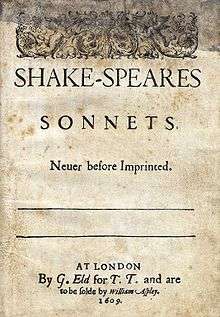Sonnet 132
Sonnet 132 is one of 154 sonnets written by the English playwright and poet William Shakespeare.
| Sonnet 132 | |||||||
|---|---|---|---|---|---|---|---|
 The first stanza of Sonnet 132 in the 1609 Quarto | |||||||
| |||||||
Structure
Sonnet 132 is an English or Shakespearean sonnet. The English sonnet has three quatrains, followed by a final rhyming couplet. It follows the typical rhyme scheme of the form abab cdcd efef gg and is composed in iambic pentameter, a type of poetic metre based on five pairs of metrically weak/strong syllabic positions. The 3rd line exemplifies a regular iambic pentameter:
× / × / × / × / × / Have put on black and loving mourners be, (132.3)
- / = ictus, a metrically strong syllabic position. × = nonictus.
Line 13 features a mid-line reversal and, potentially, an initial reversal:
/ × × / / × × / × / Then will I swear beauty herself is black, (132.13)
Lines 2, 4, and 6 also exhibit initial reversals. Line 6 may be scanned as exhibiting a mid-line reversal; such a reversal is normally preceded by at least a slight intonational break, which "grey cheeks" does not allow. Peter Groves calls this a "harsh mapping", and recommends that in performance "the best thing to do is to prolong the subordinated S-syllable [here, "grey"] ... the effect of this is to throw a degree of emphasis on it".[2]
Some rhythmic uncertainty at the beginning of lines 7 and 9 may be resolved by applying contrastive accent to line 7's "that" and line 9's "those", rendering both lines regular and foregrounding a characteristically Shakespearean antithetical construction.
The meter demands that line 1's "pitying" function as two syllables.[3] Regarding lines 5 and 7's rhymes "heaven" and "even", Booth regards them as monosyllabic, whereas Kerrigan evidently reads them as disyllabic.[4][5]
Interpretations
- Matthew Rhys, for the 2002 compilation album, When Love Speaks (EMI Classics)
Notes
- Pooler, C[harles] Knox, ed. (1918). The Works of Shakespeare: Sonnets. The Arden Shakespeare [1st series]. London: Methuen & Company. OCLC 4770201.
- Groves, Peter (2013). Rhythm and Meaning in Shakespeare: A Guide for Readers and Actors. Melbourne: Monash University Publishing. pp. 42–43. ISBN 978-1-921867-81-1.
- Booth 2000, p. 457.
- Booth 2000, p. 115.
- Kerrigan 1995, pp. 362, 210.
References
- First edition and facsimile
- Shakespeare, William (1609). Shake-speares Sonnets: Never Before Imprinted. London: Thomas Thorpe.CS1 maint: ref=harv (link)
- Lee, Sidney, ed. (1905). Shakespeares Sonnets: Being a reproduction in facsimile of the first edition. Oxford: Clarendon Press. OCLC 458829162.
- Variorum editions
- Alden, Raymond Macdonald, ed. (1916). The Sonnets of Shakespeare. Boston: Houghton Mifflin Company. OCLC 234756.
- Rollins, Hyder Edward, ed. (1944). A New Variorum Edition of Shakespeare: The Sonnets [2 Volumes]. Philadelphia: J. B. Lippincott & Co. OCLC 6028485.
- Modern critical editions
- Atkins, Carl D., ed. (2007). Shakespeare's Sonnets: With Three Hundred Years of Commentary. Madison: Fairleigh Dickinson University Press. ISBN 978-0-8386-4163-7. OCLC 86090499.
- Booth, Stephen, ed. (2000) [1st ed. 1977]. Shakespeare's Sonnets (Rev. ed.). New Haven: Yale Nota Bene. ISBN 0-300-01959-9. OCLC 2968040.
- Burrow, Colin, ed. (2002). The Complete Sonnets and Poems. The Oxford Shakespeare. Oxford: Oxford University Press. ISBN 978-0192819338. OCLC 48532938.
- Duncan-Jones, Katherine, ed. (2010) [1st ed. 1997]. Shakespeare's Sonnets. The Arden Shakespeare, Third Series (Rev. ed.). London: Bloomsbury. ISBN 978-1-4080-1797-5. OCLC 755065951.
- Evans, G. Blakemore, ed. (1996). The Sonnets. The New Cambridge Shakespeare. Cambridge: Cambridge University Press. ISBN 978-0521294034. OCLC 32272082.
- Kerrigan, John, ed. (1995) [1st ed. 1986]. The Sonnets ; and, A Lover's Complaint. New Penguin Shakespeare (Rev. ed.). Penguin Books. ISBN 0-14-070732-8. OCLC 15018446.
- Mowat, Barbara A.; Werstine, Paul, eds. (2006). Shakespeare's Sonnets & Poems. Folger Shakespeare Library. New York: Washington Square Press. ISBN 978-0743273282. OCLC 64594469.
- Orgel, Stephen, ed. (2001). The Sonnets. The Pelican Shakespeare (Rev. ed.). New York: Penguin Books. ISBN 978-0140714531. OCLC 46683809.
- Vendler, Helen, ed. (1997). The Art of Shakespeare's Sonnets. Cambridge, MA: The Belknap Press of Harvard University Press. ISBN 0-674-63712-7. OCLC 36806589.
.png)
